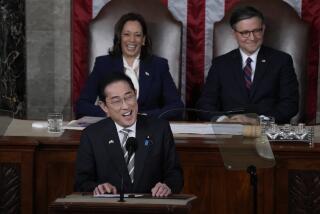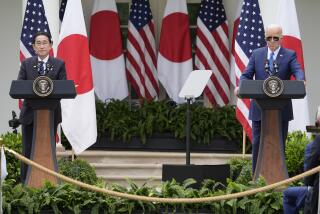NEWS ANALYSIS : Clinton’s Chance to Test Japan’s Trade Sincerity : Commerce: Today’s meeting with Prime Minister Hosokawa is an opportunity to accelerate efforts to achieve a genuine ‘new framework’ in relations.
WASHINGTON — Japanese Prime Minister Morihiro Hosokawa took office riding a tide of public demand for change, promising to end corruption in Japanese politics and--most important for the United States--pledging to finally open up the potentially lucrative Japanese market to foreign business.
President Clinton will get his first chance to test Hosokawa’s sincerity when the two meet in New York today at the opening of the U.N. General Assembly.
The new political generation in Tokyo is talking about making real progress on the bitter U.S.-Japan trade front. On the public relations front, it is taking its cues from Washington and speeding ahead into the world of sound-bite politics.
But in the private rooms where government bureaucrats operate--the nitty-gritty level at which real change occurs--the initial efforts by U.S. and Japanese negotiators to carry out a mandate for a “new framework” in trade relations have already slid back into neutral.
In the first round of talks intended to open to U.S. companies such key sectors of the Japanese economy as auto sales, construction and government procurement, officials say the old pattern has returned: tough talk on the part of the U.S. negotiators and muted responses from across the table.
The Japanese were told at the meetings last week in Hawaii that they “must take drastic action” to improve the trade relationship with Washington, a senior Clinton Administration official said, adding that if Tokyo fails to act, the U.S.-Japan ties “could be irreparably harmed.”
When it gets beyond talk and down to numbers, the scene isn’t any friendlier: The U.S. government reported last week that Japan’s imports of foreign-made semiconductors--purchases that earlier in the year were being touted as signs of Tokyo’s willingness to play ball with the United States and other potential exporters and honor its commitments--had once again fallen below targets the two nations had set.
Japan had said it would purchase 20% of the semiconductors--the tiny chips that are the brains of modern computers--from foreign producers, a goal it reached on schedule by the end of 1992, to much cheering in Washington.
But for the last two quarters, that number has fallen, slipping below the target to 19.2% for the second quarter of 1993 and prompting Mickey Kantor, the U.S. trade representative, to issue a no-nonsense statement: “It is difficult to reconcile two consecutive quarters of downward movement in market share with these commitments. This negative trend needs to be reversed immediately.”
After previous Japanese governments strenuously resisted any notion that such targets would be set--with the exception of those applied to the semiconductors after much pressure--the readiness of Hosokawa’s government to move toward relaxed trade tensions heartened officials in Washington.
Indeed, Japanese Foreign Minister Tsutomu Hata said two weeks ago that he looked favorably on an effort to boost his nation’s imports through reasonable targets. His statement was seen here as evidence that real progress was on the horizon following the July election in which a seven-party coalition ended the Liberal Democrats’ 38-year rule.
But the Associated Press reported Friday that Hosokawa told the Japanese Parliament that Tokyo and Washington have agreed not to set numerical targets for improving their trade imbalance.
Hosokawa said Clinton will not bring up the issue when the two leaders meet today. “We have an understanding from the United States . . . that they will not demand numerical targets,” Hosokawa was quoted as saying.
Hata, in comments to Parliament, also stepped back from previous statements, according to the AP report. “Numerical targets restrict free trade,” the foreign minister was quoted as saying. “The issue has already been settled between the United States and Japan.”
However, just because the subject may not be raised at the highest level does not mean the policy has shifted and won’t be addressed at a lower level.
Indeed, in Washington, a spokeswoman for Kantor said the U.S. demand for setting a numerical target for reducing the surplus has not changed.
Japan’s surplus in trade with the United States, which was $50 billion in 1992, appears to have jumped 20% and is running this year at an annualized rate of $60 billion.
Even before the Japanese statements Friday, there was skepticism in Washington that the Japanese would accept targets.
Rep. Richard Gephardt (D-Mo.), the House majority leader and a congressional expert on trade issues, said Thursday that Japanese political leaders would ever agree to set targets “is revolutionary.”
“The bureaucracy running things is an age-old tradition,” he said.
Douglas Paal, who served as the National Security Council’s expert on Japan during the George Bush Administration, was less skeptical--but also less sanguine about the near future.
“We are seeing a revolutionary change, but it will be played out at a glacial pace. Until the coalition firms up, the bureaucrats will drag their heels,” he said. “There is no one who can inspire fear in them when you have a seven-party coalition that could fracture at any time.”
That the Japanese response during the Hawaii meetings was muted was due to the delegation from Tokyo not wanting to further sour the atmosphere before Clinton and Hosokawa meet, Paal said.
The U.S. team felt that “it is conceivable that instructions had gone out to not make waves” before the New York meeting and members were not discouraged, the official said.
However, Paal said although Japan generally tries to approach such top-level sessions with some sort of “gift,” in the form of concessions, Tokyo felt it had little in the way of concrete measures to offer this month.
“They felt the cupboard was bare,” he said. Thus, he added, any improvement in the relationship that occurs these days is “mostly talk.”
More to Read
Inside the business of entertainment
The Wide Shot brings you news, analysis and insights on everything from streaming wars to production — and what it all means for the future.
You may occasionally receive promotional content from the Los Angeles Times.










